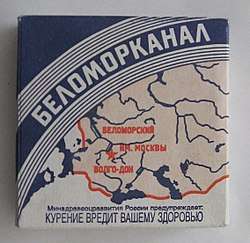Belomorkanal
Belomorkanal (Russian: Беломорканал) is a Russian brand of cigarettes, originally made by the Uritsky Tobacco Factory in Leningrad, Soviet Union.
 An old box of Russian Belomorkanal cigarettes with a Russian text warning at the bottom of the pack | |
| Product type | Cigarette |
|---|---|
| Owner | Uritsky Tobacco Factory |
| Country | Leningrad, Soviet Union |
| Introduced | 1932 |
| Markets | See Markets |
| Wikimedia Commons has media related to Belomorkanal. |
History
Belomorkanal was introduced in 1932 to commemorate the construction of the White Sea–Baltic Canal, also known as the Belomorkanal.[1][2] Process engineer Vasily Iohanidi was the creator of its tobacco blend, and the pack drawing was made by Andrey Tarakanov.[3]
Belomorkanal is a cigarette of specific design called in Russian papirosa (папироса), different from usual cigarettes. Generally, the papirosa is without a filter. Belomorkanal is an example of one of the stages in the evolution of cigarettes: it is composed of a hollow cardboard tube extended by a thin cigarette paper tube with tobacco. The cardboard tube plays the role of a disposable cigarette holder. This method was abandoned by Western brands shortly after World War II. While smoking, the hollow part of the tube is usually compressed to make two separate perpendicular flat surfaces, for the sake of convenience. Belomorkanal are still produced in various post-Soviet republics, most notably in Russia, in Kamianets-Podilskyi (Ukraine), and in Hrodna (Belarus).
The brand became popular in most of the Soviet Bloc countries due to their low price. They are famed as one of the strongest cigarettes available in Eastern Europe (if not the strongest in the world). They have also been pictured in many works of art and literature.
Belomorkanal is also used by cannabis users, wherein "emptied cigarettes are then filled with a mixture of tobacco and marijuana" for smoking,[4][5] with the cardboard tube serving as a built-in roach.
Markets
Belomorkanal cigarettes were widely available in the Soviet Union, they are still sold in some post-Soviet states, including Russia, Belarus and Ukraine.[6][7][8][9]
In popular culture
Music
In a 1985 song by Jan Krzysztof Kelus, the name of the cigarettes is compared to Auschwitz Filters due to the fact that many thousands of Gulag prisoners had died during the construction of the canal.[10]
Literature
Belomor and papirosa are referenced in the Arkady Renko books by Martin Cruz Smith.[11]
Nicolas Rothwell's 2013 novel Belomor takes its name from this cigarette.[12]
See also
References
- "Les Zeks du Canal de la mer Blanche : photographies" by Anne Brunswic and Nicolas Werth, Institut d'histoire du temps présent, 9 May 2015 (in French)
- "Russia Marks 80th Anniversary of Opening of Belomorkanal", Radio Free Europe/Radio Liberty, 2 August 2013
- Bachurin, Mikhail. "Купите папиросы!" (in Russian). PakkoGraff #6, 2008. pp. 58–61.
- Dineeva, Nelly Rod (December 1999). "Adolescent Narcotism in Russia". Heroin Addiction and Related Clinical Problems. 1 (2). p. 30. ISSN 1592-1638
- V. Anastasia (2003). "Cannibis Culture: Russia". in Dana Larsen. Grow Like a Pro: The Marijuana Advantage. Oakland, California: Ed Rosenthal. p. 52. ISBN 0-932551-60-2
- Jan Krzysztof Kelus; Tomasz Kobyliński (1985). "Papierosy Biełomor-Kanał" [Belomorkanal Cigarettes]. kelus.art.pl (in Polish). Warsaw: Polkobex. Archived from the original on 2012-04-02. Retrieved 2011-09-15.
Tak, Heinz, Kanał Białomorski/ – nie ma co się łudzić –/ tam zginęło tak najmarniej/ pół miliona ludzi/ Powiedz Willy – jako Niemiec/ chyba byś się zrzygał/ płacąc za Auschwitze z filtrem/ markę i feninga
- Martin Cruz Smith (1989). Polar Star. Random House. pp. passim.; Martin Cruz Smith (1992). Red Square. Random House. pp. passim.
- "Belomor by Nicolas Rothwell – review" by Alex Clark, The Guardian, 12 December 2013
